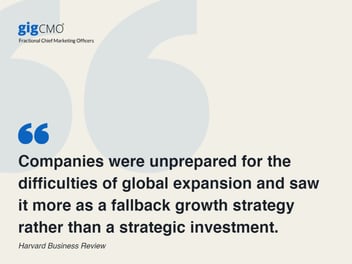
Consistently concentrating on market expansion is one of the essential elements of business success. Suppose you want to achieve sustainable long-term growth on a global scale in this intensely competitive market. In that case, developing the correct strategies and goals for expanding your firm beyond its borders is crucial. However, for successful international market expansion, you will require a robust action plan for your expansion attempts to be successful.
It’s important to assess your readiness if you are prepared to enter new markets? Take our free Market Expansion Readiness Audit to evaluate where you stand and uncover actionable insights to strengthen your global strategy.
What is international market expansion?
As you no doubt know, international market expansion or global market expansion, is when you take your business operations to a new country (target market). It isn't simply investing in another territory but setting up a legal entity in another region and conducting business there.
While global market expansion is a straightforward concept, the practicalities of doing it successfully are intricate and require a strategic approach and careful planning.
Benefits of international market expansion
International market expansion has many benefits, mainly relating to the opportunity to grow a company's profits, reputation and value. Amongst the main reasons businesses might consider expansion to new markets are as follows:
Better profit margins
As you will know, getting a company to a point where it turns over large sums of money is one thing. However, getting a company to the point where it makes substantial profits is another. Economies of scale dictate that the larger a company grows, the easier it is to profit, driving proportionate cost savings through increased production.
Less competition
Getting ahead of the competition is another reason for international expansion. You dominate the market if you are first to market and become synonymous with a particular product or service. Consider Hoover, for example, which is almost universally used to describe all vacuum cleaners. This is as much about brand reputation as it is about profit and sales.
Playgrounds for innovation
Businesses can gain from new markets in ways they had never considered. Even when people fundamentally seek out the same product, different regional preferences and ways of life will drive necessary adaptations to how you sell and sometimes even what or why you trade successfully. Competitive pressures, tastes and business structures can help you to explore, play with your ideas, and ultimately innovate if you have an open-minded approach.
New talent
One of the most significant challenges to business expansion is talent shortages. When you expand internationally, you open your business to a global talent pool. New talent will once again unlock new energy, ideas, expertise and contributions that you may have yet to consider.
Five strategies for international market expansion
To achieve and exceed your goals, you must have an international market expansion strategy to work towards and guide you. This market expansion framework is dynamic and adaptable but should be developed with the help of market expansion services or even market expansion consulting services to help you plan your approach.
Here are five strategies you should include when you're planning for international market expansion:
Choosing the right strategic model
Global market expansion is not a one-size-fits-all step in business development. As a result, there are several different strategic models to choose from to take your company to new heights.
Market expansion examples include but are not limited to:
International strategy
An international strategy is arguably the most common model for global market expansion, and many businesses leap into it without considering it from a strategic perspective. This hinges on exporting or importing goods and services while you keep a head office in your home country. So, you may have warehousing and delivery drivers, for example, in your new target market.
Transnational strategy
A transnational strategy is where you retain your head office, but you also have a local subsidiary in your new territory, which you communicate with and transact through. For the most part, decision-making is centralised, but the local office will have its own sense of identity and local knowledge. Big brands, including the likes of Nike and Coca-Cola, use this model.
Multi-domestic strategy
A multi-domestic strategy gives local subsidiaries more independence and decision-making power. They usually have their own strategic approach to sales, marketing and product and operate more like individual, local businesses rather than one global brand. These subsidiaries may even have a different name in different countries, where you don't realise they are part of a parent organisation. Johnson & Johnson operates in this way.
Global strategy
A global strategy is the preferred model of giants like Apple, which largely offers the same product and experience in every territory worldwide and seeks large-scale brand recognition. Of course, they make necessary changes (language, currency etc.), but beyond that, they are one aligned brand capitalising on core values in every nation.
Determining the correct market
Choosing the right target market (or markets) for your business and the order in which you approach them is easier said than done. There can be all sorts of reasons that companies choose to expand to one country or another, and equally, the region you instinctively lean towards is different from the best one. Deciding where to grow your business should be done based on research and analysis, including:
- Understanding the values of potential target audiences and the total addressable market (TAM) in your new territory through market segmentation
- Doing a compeer analysis (SWOT analysis (strengths, weaknesses, opportunities and threats)
- Ascertaining if your business proposition is relevant in your chosen market through a PESTEL analysis, considering the political, economic, sociological, technological, legal and environmental conditions.
Based on the market expansion models we already mentioned, the most common global market entry strategies include the following:
International strategy
Exporting
Businesses that expand by exporting products, either directly or indirectly, but under their own steam, have the advantage of being able to grow into multiple markets at the same time and retain a high level of control. However, the challenge is that achieving it can be costly and complicated.
Licensing
Licensing is a logistically easier approach to global expansion, transferring intellectual property rights to a local partner. However, through licensing, you give up some control when it comes to process and customer service, which can impact the reputation and success of your business (positively as well as negatively, as your partner should know the local region better than you.)
Transnational strategy
Franchising
Franchising is the most popular approach for businesses that adopt a transnational strategy for international market expansion. By bringing a franchisee on board to run regional locations, one who is paying a fee for the privilege, you expand your business in multiple ways, becoming a franchise model and gaining a presence in a different market. This is considered the fastest way to expand internationally. While franchising places the running of the local company in the hands of someone else, it also gives you control through corporate assistance and brand guidelines, assuming you do it well.
Multi-domestic strategy
Partnering and joint ventures
With a multi-domestic strategy for international expansion, partnering and joint ventures are one approach. These can range from less formal arrangements like marketing agreements with reputable businesses in your new market to promote trust to localised manufacturing and sub-contracting partnerships to bring your product to market.
Mergers and acquisitions
The other option for a multi-domestic strategy is mergers and acquisitions. Taking over a competitor in your chosen region is a highly effective way of entering a new market and a shortcut in terms of already having a reputation in the local market. It's a highly committed and aggressive approach but leverages the resources, knowledge and talent the local company has for business success (assuming they have a good reputation).
Global strategy
Greenfield investments
As part of a global strategy for international expansion, greenfield investments are a type of foreign direct investment. This is where you create a subsidiary and build its operations locally - almost as if you were creating an entirely new company. This is the most labour-intensive and arguably complicated approach but is widely considered to reap extensive rewards long-term.
Hiring the right team with a global-first mindset
In any business and at any business stage, the people you hire - both as part of the permanent team and outsourcing - are essential to your success. Of course, you need to consider their skills and fit within the team, but you also need to incorporate people with a global-first mindset. That means they can recognise and adapt to different cultures and work collaboratively. A global-first mindset is the basis of the culture you want to develop within your team. A global-first mindset includes everything from fluency in the local language to understanding local cultural nuances in humour, sensitivities and behaviours.
Understanding your target market
We have already touched on the concept of understanding your target market. Still, this is one of your most pivotal needs regarding successful international market expansion. It's also one of the hardest things to achieve because data does not define it.
If you're from London, you will instinctively understand parts of the humour or turns of phrase or buying habits that someone who didn't grow up there will find much harder to recognise. Equally, businesses expanding into the GCC often conflate cultures, but each region has cultural differences and processes that need to be observed and may impact your brand rollout.
Whichever market expansion strategy you use, you should still approach a local area with local expertise, understanding, and the same attention to detail as your first domestic product launch.
Managing localisation and translation
Ensuring your capabilities enhance local customer experience is essential. For example, ensuring that products are available in the local language, local currency and using the preferred local payment methods are vital.
Before you head into a new market, make sure you can manage localisation and translation for client-facing and internal requirements. For example, are there local taxes that need adding if someone purchases in a particular territory (both for internal financial management as well as for the customer experience)?
Localised and personalised experiences are the expectation of the modern customer. However, more than simply being up to date, as a business in a new and competitive market, these are the hallmarks that help generate trust and remove barriers to purchase for new customers.
Ready to expand globally? Talk to gigCMO!
Are you ready for expansion into new markets? At gigCMO, our team of Fractional CMOs and CMO Whisperers have skillsets that span industry and geographic verticals.
We have worked around the world as individuals and as a service for market expansion consulting. We elevate the CMO function and turn it into a streamlined, focused, bottom-line driven and scalable offering that spans market expansion services, perfect for guiding businesses with their expansion into a new market.
We know what it takes to grow a business into new markets because we've done it multiple times. Now, we want to help you.
Want to find out more about our Fractional CMO service?






